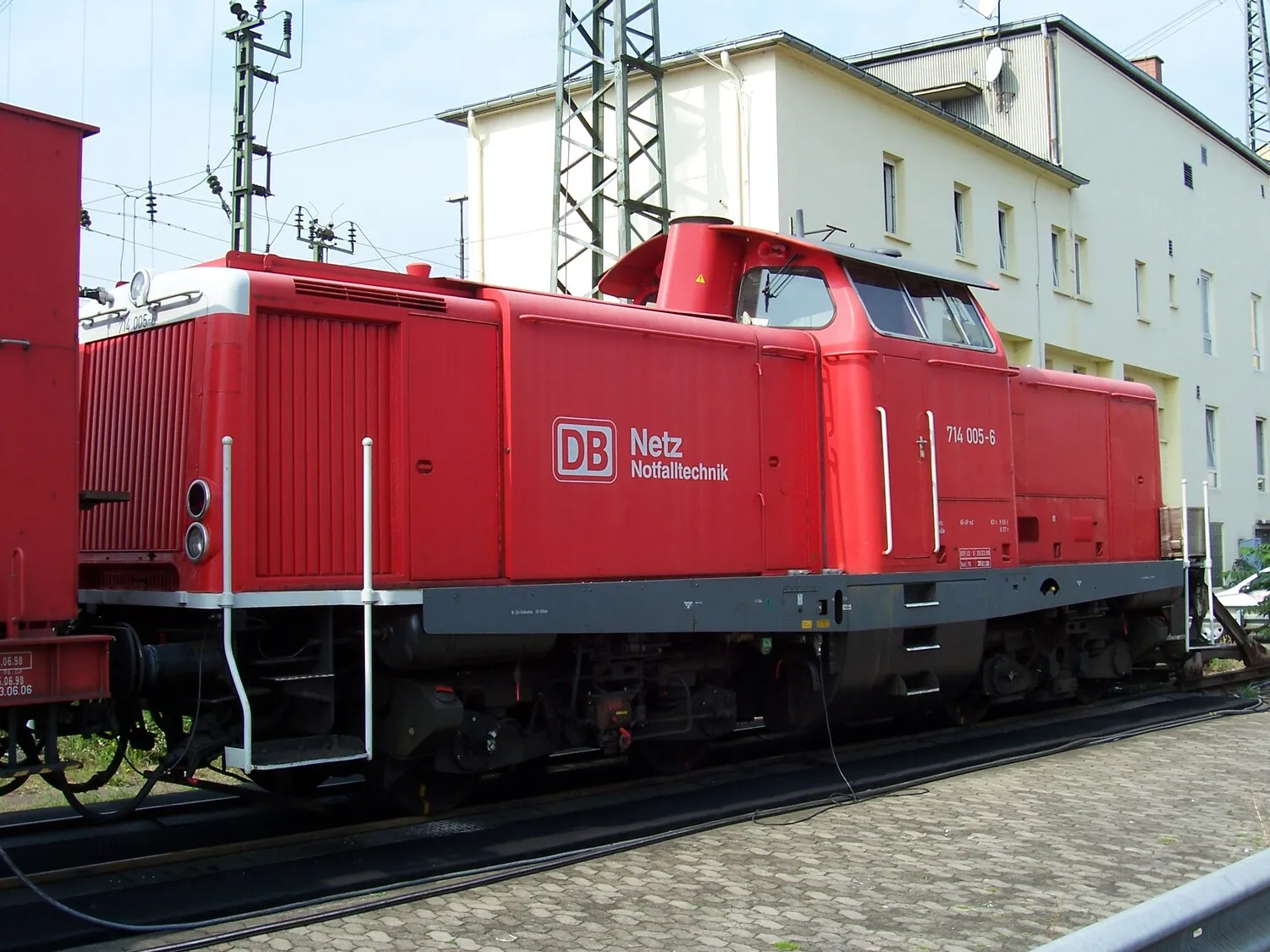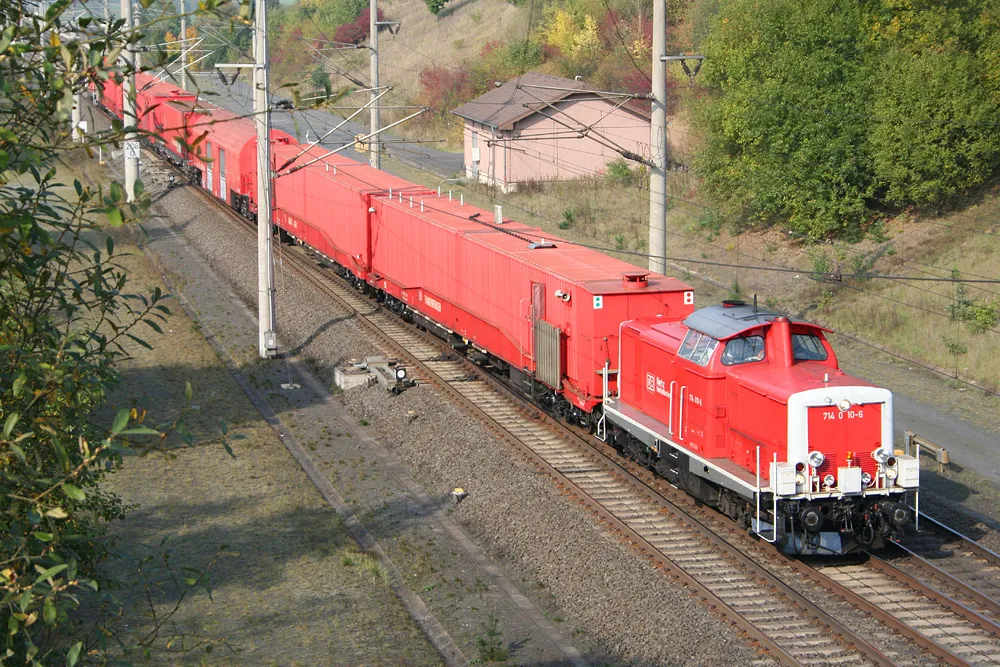
Source: de.wikipedia.org

Source: de.wikipedia.org
Class / BR 714
Also known as:
Class / BR 214
Vehicle type:
Registration country:
Railway companies:
1988
The "Tunnel Emergency Train"
("Tunnelhilfszug" or "TuHi") is
an essential rescue system developed by the Bundesbahn to address
the safety needs of the new railway line from Würzburg to Hanover,
which features numerous tunnels. The first TuHi
enters service at Fulda in May 1988, utilizing diesel locomotives
212
244-8 and 212
257-0 as Locomotive 1 and Locomotive 2, respectively.
The Würzburg TuHi follows in August 1988, incorporating locomotives
212
236-4 and 212
352-9 as its primary units, while locomotive
212
271-1 is held in reserve. The five locomotives
designated for the TuHi are reconstructed between
May and August 1988 at the AW Kassel workshop.
Each TuHi operates as a one-way train specifically designed for deployment in a single direction. The train configuration includes a transport wagon, an equipment wagon, a fire-fighting wagon, a central wagon, a first aid coach, and an additional transport wagon. The locomotives exhibit distinct characteristics; Locomotive 1 is equipped with a video and infra-red camera, two large headlights, two small headlights, and yellow flashing lights, while Locomotive 2 lacks the infra-red camera.
As of 1 January 1989, all five engines are reclassified as Class 214, maintaining their serial numbers, and are officially allocated to the Bw Würzburg depot. However, both engines associated with the Fulda TuHi incorrectly bear the inscription "Bw Fulda."
Following the inauguration of the new Hannover-Würzburg and Mannheim-Stuttgart high-speed railways on 29 May 1991 by Federal President Richard von Weizsäcker, the demand for additional TuHi units arises. Consequently, stations at Kornwestheim, Mannheim, Kassel, and Hildesheim are designated to accommodate the TuHi, alongside existing locations in Fulda and Würzburg. The TuHi stationed in Fulda is modified to function as a bidirectional train to serve both the Würzburg and Kassel routes, requiring the addition of an extra first aid coach behind the first transport wagon. The TuHi deployments at Hildesheim Hbf and Kassel Hbf are maintained as unidirectional trains for efficient operation along the high-speed links.
Between August 1990 and April 1991, eight additional locomotives, originally of Class 212, undergo modifications at AW Bremen and AW Kassel to serve the four new TuHi units. The locomotives are numbered 212 033-5, 212 046-7, 212 235-6, 212 245-5, 212 246-3, 212 251-3, 212 260-4 and 212 277-8, all retaining their original serial numbers. Differences between Locomotive 1 and Locomotive 2 are eliminated to facilitate easier maintenance exchanges. The former Locomotive 2 units from Würzburg and Fulda receive infra-red cameras in 1991 at AW Kassel, with cooling for the cameras transitioned from liquid nitrogen flasks to standard liquid air cylinders.
After a significant train accident on 15 November 1992 at Northeim, where no TuHi was deployed, a new rescue operation concept is established, leading to the rebranding of the TuHi as "emergency trains" ("Rettungszüge" or "Rtz").
By 31 October 1994, all 13 locomotives of Class 214 are redesignated by DB AG as railway works vehicles of Class 714, maintaining their original numbers but later receiving sequential designations from 001 to 013 by 1 August 1996. As one reserve locomotive is insufficient, DB AG converts two additional engines in 1996/97 at Stendal, reclassifying 212 269-5 to 714 014-8 and 212 160-6 to 714 015-5.
The locomotives undergo a livery change, as the original five TuHi units retain the classic ocean blue and beige color scheme, while the later eight are painted orient red for improved visibility against the emergency wagons. To enhance recognition, certain locomotives are painted luminous red, specifically 714 003-1, 714 008-0, 714 009-8, 714 011-4, 714 014-8 and 714 015-5, as well as the wagons in Rtz service located at Würzburg, Fulda, and Hildesheim. However, due to rapid fading of the luminous red paint, all engines and wagons are later repainted in traffic red. The inscriptions on the locomotives present a mix of designations, including the letters "Rtz," the DB insignia, and the wording "Notfalltechnik", which can lead to confusion.
All 15 engines of Class 714 are assigned to DB Netze, specifically within the central route management and railway vehicles at Fulda, where their deployment is coordinated, and they undergo regular rotations under a systematic schedule.
Each TuHi operates as a one-way train specifically designed for deployment in a single direction. The train configuration includes a transport wagon, an equipment wagon, a fire-fighting wagon, a central wagon, a first aid coach, and an additional transport wagon. The locomotives exhibit distinct characteristics; Locomotive 1 is equipped with a video and infra-red camera, two large headlights, two small headlights, and yellow flashing lights, while Locomotive 2 lacks the infra-red camera.
As of 1 January 1989, all five engines are reclassified as Class 214, maintaining their serial numbers, and are officially allocated to the Bw Würzburg depot. However, both engines associated with the Fulda TuHi incorrectly bear the inscription "Bw Fulda."
Following the inauguration of the new Hannover-Würzburg and Mannheim-Stuttgart high-speed railways on 29 May 1991 by Federal President Richard von Weizsäcker, the demand for additional TuHi units arises. Consequently, stations at Kornwestheim, Mannheim, Kassel, and Hildesheim are designated to accommodate the TuHi, alongside existing locations in Fulda and Würzburg. The TuHi stationed in Fulda is modified to function as a bidirectional train to serve both the Würzburg and Kassel routes, requiring the addition of an extra first aid coach behind the first transport wagon. The TuHi deployments at Hildesheim Hbf and Kassel Hbf are maintained as unidirectional trains for efficient operation along the high-speed links.
Between August 1990 and April 1991, eight additional locomotives, originally of Class 212, undergo modifications at AW Bremen and AW Kassel to serve the four new TuHi units. The locomotives are numbered 212 033-5, 212 046-7, 212 235-6, 212 245-5, 212 246-3, 212 251-3, 212 260-4 and 212 277-8, all retaining their original serial numbers. Differences between Locomotive 1 and Locomotive 2 are eliminated to facilitate easier maintenance exchanges. The former Locomotive 2 units from Würzburg and Fulda receive infra-red cameras in 1991 at AW Kassel, with cooling for the cameras transitioned from liquid nitrogen flasks to standard liquid air cylinders.
After a significant train accident on 15 November 1992 at Northeim, where no TuHi was deployed, a new rescue operation concept is established, leading to the rebranding of the TuHi as "emergency trains" ("Rettungszüge" or "Rtz").
By 31 October 1994, all 13 locomotives of Class 214 are redesignated by DB AG as railway works vehicles of Class 714, maintaining their original numbers but later receiving sequential designations from 001 to 013 by 1 August 1996. As one reserve locomotive is insufficient, DB AG converts two additional engines in 1996/97 at Stendal, reclassifying 212 269-5 to 714 014-8 and 212 160-6 to 714 015-5.
The locomotives undergo a livery change, as the original five TuHi units retain the classic ocean blue and beige color scheme, while the later eight are painted orient red for improved visibility against the emergency wagons. To enhance recognition, certain locomotives are painted luminous red, specifically 714 003-1, 714 008-0, 714 009-8, 714 011-4, 714 014-8 and 714 015-5, as well as the wagons in Rtz service located at Würzburg, Fulda, and Hildesheim. However, due to rapid fading of the luminous red paint, all engines and wagons are later repainted in traffic red. The inscriptions on the locomotives present a mix of designations, including the letters "Rtz," the DB insignia, and the wording "Notfalltechnik", which can lead to confusion.
All 15 engines of Class 714 are assigned to DB Netze, specifically within the central route management and railway vehicles at Fulda, where their deployment is coordinated, and they undergo regular rotations under a systematic schedule.
Do you have additional informations regarding this vehicle?
Help us writing the history of Class / BR 714! Your knowledge is precious for us and the entire community, do not hesitate to share your facts, photos or videos:
Latest update on the 14th of December 2024 at 21:28
Contributor(s): Tudor C.
Discussion forum






